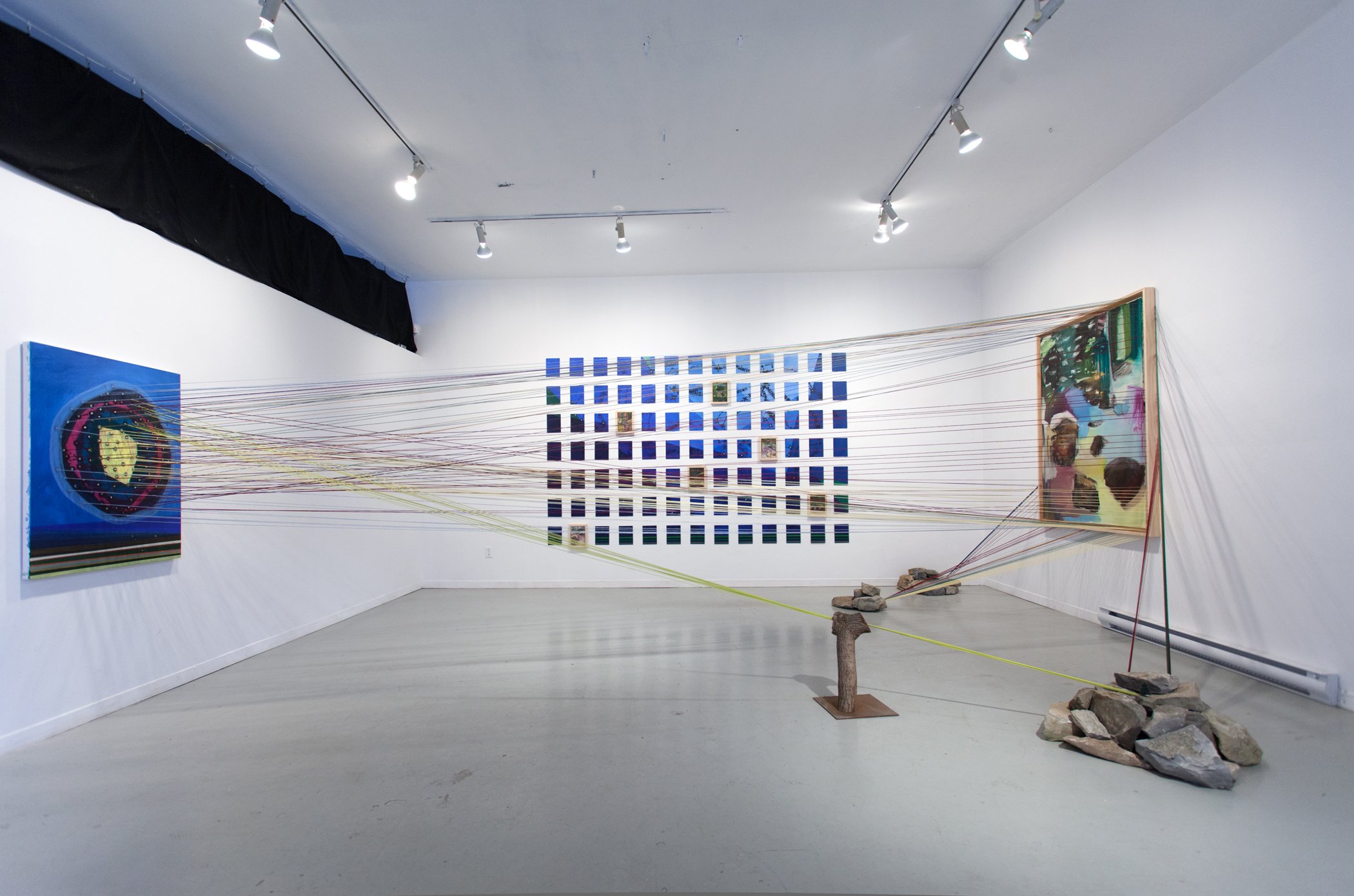
A Veritable Hotbed of Apparitions
Essay by DONNA-LEE IFFLA
"In my art, there is a sense of contemplation or of reverie that speculates on fundamental mysteries–this being the result of a lot of camping under an expansive sky in the northern Canadian wilderness." –Jason Paradis
Jason Paradis, whose very name suggests a voyage to the sublime and the enigmatic, brings work back to Kingston in a virtuoso gesture that is indicative of one of his central preoccupations: "a moment when the past, present and future collide." He is unclear as to whether it is his past, present and future which are colliding, or a more general phenomenon, but it is that ambiguity which, to my mind, opens an intriguing dialogue between the private and the public in his art.
Collide seems too violent or harsh a word for art which is at once striking and nuanced. He describes a layering process which is demanded by the "disjunction" of his current context, his memory and his speculation, but to me the visual experience he ends up creating is culturally complex, subtle, and more of a conjunction of the physical and the metaphysical, the private and the public. Mysterious as hell, but in a good way.
At present Jason Paradis works in the New York area, and describes himself vaguely as being "from Canada" (born here? entered the U.S. via one of our "soft" border points? or, given his name, hailing from an entirely more, uh, spiritual place? I think we should be told. Pester him with personal questions at the opening). Certainly he went camping--a lot of camping, he claims--in "the northern Canadian wilderness" (Hmmm...again with the vagueness--Rankin Island? Attawapiskat? Sharbot Lake?) and those experiences inform the strength and beauty of much of his work, his painting/assemblages and installations especially. Apart from being kaleidoscopic in colour and shape, his installations appear to join endless sky and primeval aspects of landscape, heaven and earth, or perhaps past and future, in a series of pathways that guide you into the work. This ambiguity provides a mysterious charm to what we see.
As a graduate of the BFA program at Queen's, Paradis has a history in the Kingston area and in relation to his painting installation currently on view in Modern Fuel's Main Gallery, he has produced a number of paintings of Dead Man's Bay. Before you nod sagely about Dead Man's Bay, I didn't know where it was, either. But let me be the first to tell you the bay is bracketed by CFB Kingston and Cartwright Point and has an imposing limestone building called Martello Tower on Cedar Island in the centre of it. It is now the site of Arrowhead Beach Park. But get this: Dead Man's Bay is haunted. In fact, according to Haunted Sites in North America (http://www.hauntednorthamerica.com/kingston.htm) we are living in a veritable hotbed of apparitions, anomalies of light, and ghost ships, on that site particularly. And here I thought K-town was just prisons, a military base, a university which takes itself very seriously, and an under-resourced dog park at the Memorial Centre. Who knew?
Dead Man's Bay, was once called Hamilton Cove. But then, in 1847, 23 Irish Stonemasons were returning from playing adult Lego with limestone on Cedar Island, building the above-mentioned Martello Tower. Maybe they were all longing for a pint in the Fort Henry pub, or tut tut, it looked like rain, but for whatever reason too many of them were on board and a swell capsized their crowded craft. Seventeen men were drowned.
One of the stonemasons who lost his life was one Robert James, who had recently become engaged to his sweetheart Elizabeth. She died shortly after him from "complications due to intense grief." Talk about speculation... Hence, the reported ghosts are of a woman on the beach looking for something, a couple on the beach walking towards the tower, and a host (a fleet?) of ghost ships, since a number of British naval vessels were scuttled in the bay early in the nineteenth century. Given these published histories of Dead Man's Bay, we are left to speculate on whether Paradis has also been inspired by a more private experience at the site. Is this collision or collusion? Or scuba diving?
In any event, the tragic occurrences in the nineteenth century are public history and may have little or nothing to do with what has motivated Paradis to make this work. Nevertheless, whilst Jason Paradis may be specifically concerned about his own environment, his thoughts about his past here in Kingston and his contemplation about his future, in his current arts practice, and in surprising ways, his work invites our speculation and reaches out to the viewer as a startling and unique gateway to the history--and the mysteries--around us.
"The pieces end up feeling like some sort of phenomenon (either natural or supernatural) has occurred, or is occurring. They are at once primitive, timely, and futuristic." –Jason Paradis
Donna-lee Iffla is a performance poet and independent food and beverages professional based in Kingston, Ontario. Her recent exhibitions include Shades of Grace, which she organized for the Union Gallery in Kingston.